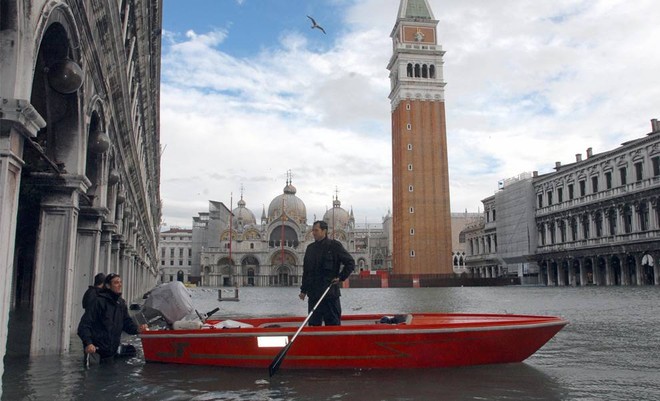Venice's high-tech flood gates could spell hope for world flood zones
by Jeni Bone on 27 Feb 2012

Venice has experienced constant flooding this northern winter. SW
As much of the east coast of Australia still counts the cost of last year’s inundation and this summer’s less servere repeat, spare a thought for the 1300 year old city of Venice, experiencing flooding 100 times a year. Fortunately, an ultra high-tech gate concept is under construction, aiming to save the sinking city which is concurrently being cannibalised by its canals.
In 1900, Venice was flooded 10 times. Now, it’s closer to 100 times a year.
Considered by UNESCO as 'a unique artistic achievement' and utterly worthy of saving, the city is built on 118 small islands that dot the waters of the lagoon. In this lagoon covering 50,000 km2, nature and history have been so closely linked since the fifth century AD when Venetian populations, to escape barbarian raids, found refuge on the sandy islands of Torcello, Iesolo and Malamocco.
These temporary settlements gradually became permanent and the initial refuge of the land-dwelling peasants and fishermen became a maritime power.
Now experts agree that global warming is causing sea levels around the world to rise and environmental experts assert that Venice may well go the same way as Atlantis.
In his book, Venice Against the Sea: A City Beseiged, author John Keahey states that Venice is sinking - six feet over the past 1,000 years.
'The reasons for this are many,' he writes. 'Although there is a natural geologic tendency for some sinking, humans have exacerbated the problem by exploiting on a massive scale underground water resources for industrial purposes. Coupled with these events - and perhaps most significant - are climatic changes all over the globe. The heating of the atmosphere after the last ice age, dramatically speeded up by humans, has led to a steady, continuing rise in sea level. This global warming is likely to persist beyond human control for hundreds, if not thousands, of years.'
Venice Against the Sea explains how the city and its 177 canals were built and what has led up to this long-foreseen crisis. It explores the various options currently being considered for 'solving' this problem and chronicles the ongoing debate among scientists, engineers, and politicians about the pros and cons of each potential solution.
In September 2003, work began on a globally significant project to construct gates to prevent the inevitable rise of the sea. The estimated cost has since blown out from 3 billion to around 5.4 billion euros and more than 3,000 people are currently involved in the general works, planning and construction.
Known as the MOSE project (MOdulo Sperimentale Elettromeccanico, Experimental Electromechanical Module), the concept of large gates intended to protect the city of Venice from floods is an integrated defense system consisting of rows of mobile gates able to isolate the Venetian Lagoon from the Adriatic Sea when the tide reaches above an established level (110 cm) and up to a maximum of 3 m (9.8 ft).
Together with other measures such as coastal reinforcement, the raising of quaysides and paving and improvement of the lagoon environment, it is hoped these high-tech barriers will protect the city from extreme floods.
Covered with much hype and heralding it as the saviour of Venice, the gates were the star of a Discovery Channel documentary 'Extreme Engineering', which showed their potential and the intricate functioning of the concept.
The 78 giant box-shaped -barriers will be divided into four sections at the head of the three inlets that link the lagoon with the Adriatic Sea.
They will be inserted into immense tanks on the sea floor. Should high waters threaten the city, pressured air will be pumped into the barriers, raising them up on hinges to block the tidal flow.
Once the danger has passed, the air will be expelled and the barriers would fill with water and sink back to the sea floor. Specially formulated cement and non-oxidizing steel have been used for the 60m wide girders which, at 27m high, are as tall as a seven-story building.
When not in use, the gates will lie flat against the lagoon floor. At the threat of a high tide, hydraulic valves can be opened at the flick of a switch allowing the gates to pivot into position.
Work on the project has been under way since 2003 at the three lagoon inlets of Lido, Malamocco and Chioggia, the gaps connecting the lagoon with the sea and through which the tide ebbs and flows.
Phase one saw dredging machines begin to remove 3.8 million cubic metres of clay from the lagoon bed at the mouth of its three inlets.
This is being replaced with 9m tons of rock and concrete to provide a sturdy foundation to fix the 79 steel floodgates. Each is bigger than a football field and weighs over 300 tons.
At a cost of around US$7.9 billion, the project isn’t exactly cheap. But then, it’s less than the estimated losses due to flooding. The MOSE project is scheduled for completion in 2014.
'Once finished, the system will protect Venice from high water levels of up to 3m,' said architect Flavia Faccioli from the Venezia Nuova consortium, which is composed of 50 companies.
'We’re on schedule so far,' he added. 'We have already carried out 3 billion euros worth of works and will be carrying out the first test in July 2012.'
Low lying areas like New Orleans and Brisbane can only hope MOSE represents a new era in fighting the tide.
More at www.boschrexroth.com
If you want to link to this article then please use this URL: www.sail-world.com/94328